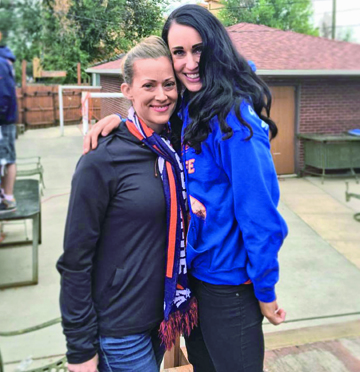
by Mark Smiley | Nov 2, 2015 | Travel
by Mark Smiley
 Cherry Creek Valley resident Elizabeth (Biz) Erickson, age 31, watched as her sister Emily, age 36, slowly wasted away and began to die from the liver disease Primary Sclerosing Cholangitis (PSC) as she waited for a transplanted liver from a cadaver. Football legend Walter Payton died from PSC at age 45 and now his football coach Mike Ditka has the very same disease.
Cherry Creek Valley resident Elizabeth (Biz) Erickson, age 31, watched as her sister Emily, age 36, slowly wasted away and began to die from the liver disease Primary Sclerosing Cholangitis (PSC) as she waited for a transplanted liver from a cadaver. Football legend Walter Payton died from PSC at age 45 and now his football coach Mike Ditka has the very same disease.
Every year thousands die while waiting for a cadaver liver which never comes. Emily’s dilemma was made even more acute from the fact that she has a relatively rare blood type, AB+. Elizabeth could no longer watch her sister suffer and volunteered to help try to save her sister’s life by offering the gift of her own liver or more accurately, 65% of her liver. Luckily livers are one of the most regenerative portions of the human anatomy and if the operation is successful, both women will eventually have full livers. But the operation is not without serious risks for both the donee and the donor.
Out of every 100 people who receive a liver transplant using a living donor, 78 will live for five years or more and 22 will die from the transplant. The odds for the donor are better with approximately one in five hundred dying from the operation.
Transplant
On December 8, 2015, University of Colorado Hospital (UCH) surgeons will transplant a portion of Elizabeth’s liver in Emily’s body. The sisters will spend 5-10 days at UCH and once they are stable, they will be taken to a transplant recovery area to continue recuperating. It takes about 2-4 months of rest, rejuvenation, and regeneration at home. The liver will regenerate in Biz’s body within months and there is a chance that Emily may be close to feeling 100% in six weeks, a feeling that she has not had in over 13 years.
The sisters’ mother, Kathy Barrett, stated, “This is an unbelievable gift Elizabeth is giving to her sister. Elizabeth is my hero too. This is the kind of person she is. This is what she is supposed to do. I’m not even that scared.”
PSC is a chronic disorder of the liver in which the bile ducts outside the liver (the extrahepatic bile ducts) and often the bile ducts inside the liver become inflamed, thickened (sclerotic), narrowed, and finally obstructed. This is a progressive process that can in time destroy the bile ducts.
Thirteen years ago after Emily gave birth to her son she had severe itching which created painful scabs. Her liver enzymes were evaluated and she was initially diagnosed with hepatitis. But after a visit to the Mayo Clinic, her diagnosis was changed to PSC. Her mother Kathy remembers these days vividly. “For me, this has been such a long journey. In the beginning, I was mamma bear and I wanted to fight for the whole thing,” said Kathy. “The first time she got sick, I was off the charts crazy. But then a calm came over me and I said, ‘I can’t control this.’”
The symptoms that Emily currently deals with are extreme fatigue, itching, and a reversed sleep cycle. Her two children are now 13 and 9 years of age. They struggle to understand why their mom is always tired. This transplant is necessary to give her children the childhood she feels they deserve. “I feel like I am living someone else’s life,” said Emily. “I have a lot of guilt associated with it [being tired around her children]. I have no energy to do anything. But if this operation is successful my children will see for the first time the energetic and joyful person that their mother was before PSC struck.”
Support Group
Emily relies heavily on a support group based in Colorado. She attends regular conferences and gets advice from experts. PSC Partners Seeking a Cure, headquartered in Englewood, Colo., is a volunteer organization that was formed in 2005 to provide PSC patients and their caregivers education and support and to raise funds to research the origins of and a cure for the disease.
Donor Alliance
While Emily will be receiving a live transplant from her sister most individuals with PSC must depend upon a liver from a cadaver. Sixty-seven percent of adult Coloradans have registered to be an organ and tissue donor which is a much higher percent than most states.
The registration process is through an organization called Donor Alliance, headquartered in Glendale, Colo. Donor Alliance is an organization that facilitates the donation and recovery of transplantable organs and tissues; the mission is to save lives through organ and tissue donation and transplantation. Every 10 minutes, another person is added to the waiting list.
After waiting on the list, Emily grew increasingly more frustrated. “I made myself inactive because I was scared. I had gotten sicker and sicker. I was in the hospital in early September with fluid buildup.” That fluid buildup became infected which made Emily’s disease more life threatening and Biz’s donation all the more vital.
As children growing up, Emily and Elizabeth, along with their sister Kate (who will be flying into Denver to be with her mom during the operation), were normal, everyday sisters. “Emily was the boss as the older child,” said Kathy Barrett. For example, she would have them pay her to go into her room.”
Now, Elizabeth has the ability to give her sister Emily the greatest payment anyone could ask for. “You get to give the most beautiful gift that anyone can give, which is the gift of life,” said Elizabeth.
For more information about organ and tissue donation, visit DonorAlliance.org. To register to be an organ and tissue donor, visit DonateLifeColorado.org or call 303-329-4747 for more information. For help or support, visit the PSC Partners website at www.pscpartners.org.
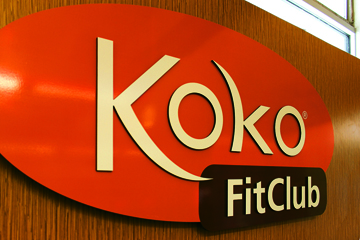
by Mark Smiley | Sep 25, 2015 | Travel
by Megan Carthel
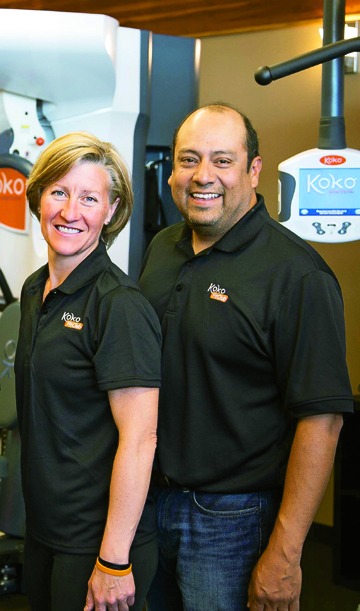 The walls of Koko FitClub, located at 6231 E. 14th Ave. in Mayfair, aren’t lined with mirrors and weight racks. Instead, a simple layout with a handful of elliptical, treadmill and weight machines fill out the small space. In fact, no mirrors will be found in this gym, and that’s just the point. “It’s not about being skinny or weighing 120 pounds,” franchise owner Jennifer Mercado said. “It’s about being strong.”
The walls of Koko FitClub, located at 6231 E. 14th Ave. in Mayfair, aren’t lined with mirrors and weight racks. Instead, a simple layout with a handful of elliptical, treadmill and weight machines fill out the small space. In fact, no mirrors will be found in this gym, and that’s just the point. “It’s not about being skinny or weighing 120 pounds,” franchise owner Jennifer Mercado said. “It’s about being strong.”
It’s no secret that Americans aren’t the trimmest. The National Institute of Health estimates nearly 70 percent of Americans ages 20 and up are overweight or obese. Mercado and her husband, Kevin, along with Koko Fitness, are trying to make that statistic smaller. After he suffered a heart attack at age 39, the Mercados knew they needed to change their lifestyle.
At Koko FitClub, technology is the personal trainer. It’s a marriage of both computers and fitness — a metaphorical match to the Mercados. Kevin, a software engineer, and Jennifer, a runner and formerly from a corporate environment, blend with the gym. “For me,” Mercado said, “it seems like one of the smartest ways technology can be there to help people get better and improve their life.”
So how is technology helping people lose weight? The answer is much like a game. Each member has their own website and USB drive that retains all of their information, such as height, weight, BMI, workouts and nutrition. Each workout is pre-planned and tailored to each member. Every part of the experience is tracked and designed to motivate. Club members carry their USB flash drives on colored lanyards correlated to the amount of time they’ve been training at the gym. Mercado said it’s a way for members to show pride in their progress.
A screen in the middle of the gym proudly flaunts member names on a “leader board” for perfect workouts. While burning calories, club members can have their pick of scenic routes and keep up with a pacemaker. At the end of each workout, members are rewarded with points. A perfect workout gets a member a free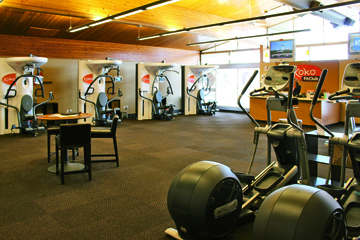 T-shirt and their name on the leader board. Think of a gold star sticker, but for adults.
T-shirt and their name on the leader board. Think of a gold star sticker, but for adults.
“It makes it a little fun, but it’s a great workout,” said club member Daniel Kraus, 29. Kraus said he’s never been a fanatic of gyms, but the streamlined ease of Koko is a perfect fit for him.
Kathy Adams, a 70-year-old member, said she checks the leader board every time she works out. This was a surprise to Adams who said she has always been a “do-it-yourselfer.” This simple work-for-reward technique seems to be one of the key motivational points for Koko FitClub. “It is that feeling, I think,” Mercado said, “that people just want to be recognized for working hard and feeling good about it.”
And, in a world of instant gratification, instant results can undoubtedly be motivational — and that’s what the technology at Koko FitClub can provide people. It’s real time data showing real time results. “The numbers don’t lie,” Adams said. “That in itself is very motivating. You can start seeing improvement. You don’t think you’re getting better, you know on paper you’re getting better and stronger.”
Mercado said many people quit trying to get healthy and lose weight because they don’t see results. The “smart trainer,” as it’s called, keeps track of the improvement each member makes during their workouts and shares the data instantly as well as on a personalized website. Koko FitClub seems to have found a way to simplify a very complicated thing. When club members come into the gym, everything is mapped out for them, from weight to reps.
Nutrition isn’t spared, either. Recipes and meal guidelines are part of each member’s website — something that Nel Lenhart, 50, a club member, said has made a positive impact on her family. The gym itself gives off a family feeling. Lenhart describes the atmosphere as “encouraging” and “comfortable.” Mercado said when people go into a large gym environment, they can sometimes be intimidated and uncomfortable asking for help, the exact opposite of what Mercado  and the Koko FitClub conveys. “You get the sense that people are glad I’m here, and they’re proud of me for showing up,” Lenhart said.
and the Koko FitClub conveys. “You get the sense that people are glad I’m here, and they’re proud of me for showing up,” Lenhart said.
Because the workouts are easy to follow, the fear of being “that person” at the gym is basically eliminated. “You don’t have to worry about the whole gym thing, going in with all these people, not knowing what you’re doing or waiting for this machine or that machine,” Kraus said. Koko FitClub supports a friendly environment and pushes the goal of health, not just quick weight loss. “We are the life prescription keeping people healthy,” Mercado said.
For more information call 303-872-8380 or visit kokodenver.com.
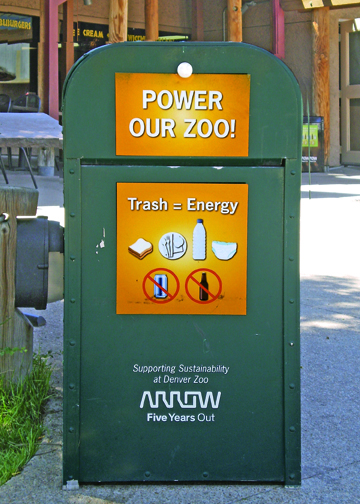
by Mark Smiley | Aug 31, 2015 | Travel
by Josh Schlossberg
The Denver Zoo is more than halfway through the construction of a first-of-its-kind energy facility to be fueled by elephant manure and trash — including plastic and food scraps — that would provide 20 percent of the Zoo’s electricity, and heat its elephant exhibit.
The self-described “greenest 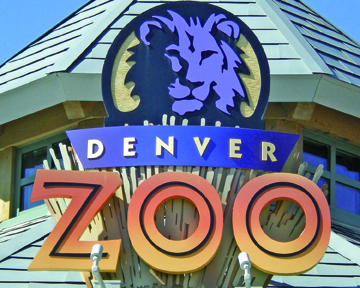 zoo in the country” is framing its plan to convert millions of pounds of annual waste into an alternative fuel source as an environmental leap forward that will help it achieve its goal of Zero Waste by 2025.
zoo in the country” is framing its plan to convert millions of pounds of annual waste into an alternative fuel source as an environmental leap forward that will help it achieve its goal of Zero Waste by 2025.
Critics, however, including local residents, the Rocky Mountain Chapter of the Sierra Club, the former director of the American Environmental Health Studies Project, and a U.S. Environmental Protection Agency (EPA) scientist, voice concerns ranging from air pollution, undermining of recycling and composting efforts, and environmental justice issues.
The Denver Zoo declined requests by this reporter for a tour, interview, or statement for this article.
Green Light For Green Energy?
The Zoo’s “biomass gasification system” has been 10 years in the making, developed by Zoo staff in partnership with the City and County of Denver, National Renewable Energy Labs, Colorado Department of Public Health and Environment (CDPHE), Colorado School of Mines, and University of Colorado.
The facility, which is 50 to 75 percent installed, according to minutes from a June 3, 2015, Denver Zoological Foundation meeting, is located in the Toyota Elephant Passage Exhibit on the Zoo’s southern boundary, adjacent to Duck Lake in City Park.
The project has undergone technical review by CDPHE and the City Council, received its construction permit, and is awaiting approval for an air permit. The State also issued water quality and sewer use permits, though a wastewater permit will not be granted until the facility is operational and liquid waste can be analyzed for potential contaminants.
Fuel To The Fire
The Denver Zoo gasifier will source its fuel from 750,000 pounds of elephant dung per year, along with 3 million pounds of waste from the zoo and outside sources, including: wood chips, food waste, waste paper, biodegradable plastic, non-biodegradable plastic, aluminum and other metals, according to a June 20, 2013, email exchange between EPA and CDPHE. Denver Zoological Foundation minutes state that fuel will be “87-89% biomass depending on the season.”
The materials will be shredded, dried, and converted into pellets and exposed to high temperatures in a low-oxygen environment to create a combustible synthetic gas (syngas), that will be mixed with natural gas to power generators, supplying 20% of the Zoo’s electricity. The leftover heat will run through pipes to heat the Toyota Elephant Passage Exhibit.
The facility is permitted as a controlled partial combustion system, with some aspects of the technology kept from the public as trade secrets. Trash and biomass gasifiers are still in the experimental stages and “not yet proven in commercial applications,” according to the National Renewable Energy Labs.
While the Zoo has avoided the use of the term incinerator, the EPA-funded Combustion Portal defines an OSWI (Other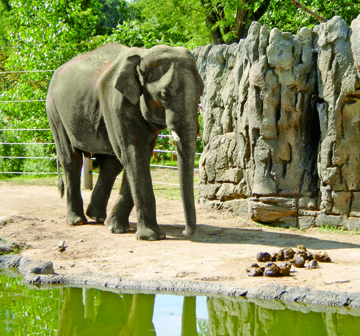 Solid Waste Incinerator) as “incinerators that due to their small size or other characteristics are not covered under other incinerator air emissions regulations.” The Zoo’s Engineering Design and Operations Plan (EDOP) states that the Zoo will follow the OSWI requirements, while referring to the “incineration (thermal conversion) of waste material.”
Solid Waste Incinerator) as “incinerators that due to their small size or other characteristics are not covered under other incinerator air emissions regulations.” The Zoo’s Engineering Design and Operations Plan (EDOP) states that the Zoo will follow the OSWI requirements, while referring to the “incineration (thermal conversion) of waste material.”
The construction permit issued by CDPHE explains that the facility will utilize a thermal oxidizer — which the EPA refers to as a thermal incinerator — for start up and shut down, where excess gas will be combusted in a flare.
Zoo staff will remove tars that build up in the scrubber and send them through the gasifier. Up to 60,000 pounds of ash per year will be a byproduct of operations, which will be landfilled.
The Solution To Pollution
The facility’s potential impact on local air quality and effects on public health is the main concern of neighbors.
According to the construction permit, the facility can emit up to the following levels of air pollutants per year: 6.3 tons of particulate matter (PM), 6.3 tons of PM 10, 6.3 tons of PM 2.5, (which can cause lung disease), 14.6 tons of Nitrogen Oxides (respiratory problems), 0.22 tons of Sulfur Dioxide (respiratory), 9.3 tons of Volatile Organic Compounds (which are carcinogenic), and 31.8 tons of Carbon Monoxide (reduces oxygen to heart, brain, and tissues).
The Zoo will also emit small amounts of dioxins, which, according to the EPA, are “highly toxic and can cause cancer, reproductive and development problems, damage to the immune system, and can interfere with hormones.”
Paul Connett, PhD, former director of the American Environmental Health Studies Project and author of the book Zero Waste Solution, spoke at the Ford-Warren Branch of Denver Public Library on July 30 about the health and environmental impacts of trash incineration and gasification.
“You should not be conducting such experiments in a residential area or near exotic animals that may be super sensitive to some of the air pollutants,” said Connett of the Zoo’s gasifier. “This project can only be considered an ongoing experiment.”
Joan Seeman, Toxics Issue Chair of the Rocky Mountain Chapter of the Sierra Club, said the group “does not support the Denver Zoo’s waste to energy incineration system.”
“It has proven impossible for industry to develop a combustion process that does not produce unacceptable toxic and hazardous air emissions,” said Seeman.
Bridget Walsh, a City Park neighbor, and one of the leading voices against the Zoo’s facility, said the Zoo’s presentation of the facility to the public has been “lacking in detail about serious health and safety risks.”
The siting of the facility has also attracted the attention of the federal government. Kendra Morrison, environmental scientist for the U.S. Environmental Protection Agency’s Air Permitting, Modeling, and Monitoring Unit, wrote in a June 19, 2013, email to CDPHE that that facility is being built in the “heart of the city near sensitive populations, both in terms of EJ [environmental justice] communities and ecological populations.”
Environmental justice, as defined by EPA, includes “fair treatment and meaningful involvement of all people regardless of race, color, national origin, or income.”
Waste Not, Want Not
The Denver Zoo characterizes the facility as part of its plan to achieve Zero Waste by 2025. However, Zero Waste International Alliance, which has adopted a peer-reviewed internationally accepted definition of Zero Waste, defines it as products or processes that “conserve and recover all resources, and not burn or bury them.”
Kate Bailey, Program Developer for Eco-Cycle, a community recycling processor and Zero Waste advocacy organization based in Boulder, doesn’t buy the Zoo’s Zero Waste claims.
“We believe that materials should be recycled or composted first,” said Bailey. “Our understanding is that this facility is taking away some of these materials that can be recycled and fed to the plant instead, undermining current recycling efforts.”
Currently, the 750,000 yearly pounds of elephant manure is routed through an undisputed Zero Waste pathway, A1 Organics. The industrial composting company based in Eaton, Colorado, has been processing the material into compost for soil amendments for years.
“We’ve enjoyed our relationship and love d the product and always been willing to compost it,” said Bob Yost, Vice President and Chief Technical Officer for A1 Organics.
d the product and always been willing to compost it,” said Bob Yost, Vice President and Chief Technical Officer for A1 Organics.
The 60,000 yearly pounds of ash produced by the facility, destined for the landfill, will contain varying levels of heavy metals including arsenic, barium, chromium, cadmium, lead, selenium, and silver. Other waste byproducts include scrubber residues, which consist of tars, liquids, and acids.
Passing Gas
Though the gasifier has been advertised by the Zoo as an alternative energy facility powered by renewable energy, it will also burn up to 7 MMBTU/hr of natural gas, along with trash and manure.
According to a plaque at the Zoo, Encana Oil & Gas gave $500,000+ to the project, while Pioneer Natural Resources (which closed its Denver office in May) made a $25,000-99,000 financial contribution, to “show the public how natural gas can solve both economic and environmental challenges.”
Western Energy Alliance, “the voice of the Western oil and natural gas industry,” donated “under” $25,000. On its website, the Alliance refers to “overregulation at the federal level” of oil and gas production, including the controversial practice of hydraulic fracturing or fracking for natural gas. Mesa Energy Partners, an oil and gas development firm, also contributed “under” $25,000.
Safety First
Aside from the routine emissions from the facility, some neighbors worry about accidents that may pose a risk to the public.
The Zoo produced a January 2014 document detailing what would happen in case of an “upset condition,” which can involve temperature or pressure exceedance, high levels of carbon monoxide or hydrogen, or other malfunctions and errors. In these cases, the gas would be directed through a release valve on the roof of the facility or through the flare, and operations would be shut down.
Waste-to-Energy Plant Process Safety Challenges, a 2011 study from the UK, notes that gasification facilities involve safety issues similar to chemical process plants, warning of “explosion hazards, fire hazards and toxic gas.”
Intelligent Energy for Europe, a project of the European Commission to support renewable energy, delineates some dangers of gasifiers in their 2009 document, Final Guideline for Safe and Eco-Friendly Gasification, specifically “increased hazard potential due to the fact that a potentially explosive, toxic and combustible gas mixture is produced and consumed.”
“Poisoning, danger of suffocation…and pollution of the environment and plant vicinity,” from the release of hazardous gases and liquids, are noted. Where pressure builds up, gas can escape into the atmosphere resulting in a “toxic atmosphere.”
Toxic liquid escapes can lead to environmental hazards and pollution.” If flammable, there is the risk of formation of “a combustible vapour cloud.”
Green Or Gross?
The Denver Zoo has invested millions of dollars to generate a fifth of its electricity through its waste stream, and in doing so, has gotten pushback from locals, advocacy groups, and scientists. Will the Zoo’s installation of this experimental “waste-to-energy” facility ultimately enhance the Zoo’s green profile, as intended, or will it sour relationships with Denver residents, neighborhood associations, and environmentalists?
Many questions remain in regard to sustainability, air pollution, and environmental justice issues surrounding the project and resident complaints of the Zoo’s unwillingness to communicate with them only fuel the controversy.
Since Zoo officials have chosen not to engage in further dialogue with Denver residents nor speak with the media, unless the project falls through, it seems that questions will only be answered once the facility is up and running.
by Mark Smiley | Aug 3, 2015 | Travel
by Mark Smiley

Many families in the Cherry Creek Valley with young children sooner or later have to make the momentous decision of whether to take the kids to Disneyland in Anaheim, California, or Disney World in Orlando, Florida. In the last 14 months, I have experienced both theme parks. Now Chronicle readers will be able to compare the two parks and my recommendation will be shared to help you decide if you are torn between the two.
When my family and I traveled to Disneyland in May 2014, we flew Southwest Airlines non-stop into Ontario International Airport. This airport is much less congested than LAX and is about a one hour drive from the park. When visiting Disney World in Orlando, we flew into Orlando International Airport. Flights are approximately $100 more per roundtrip ticket to Orlando. If you are staying at a Disney Resort in Orlando, you are transported from the airport to your resort and Disney reclaims your luggage for you. The next time you see your luggage is in your room.
Surprisingly, there is little difference in the amount of travel time to either destination which most families consider before booking a trip. It takes about one and a half hours extra to travel to Orlando. However, the inevitable California traffic jam significantly cuts into that 90 minutes you save.
Weather is, of course, a factor and in general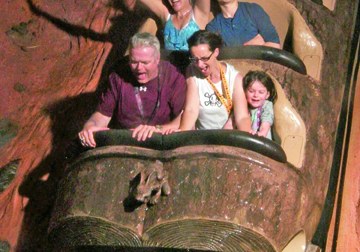 Anaheim is much cooler and more comfortable than Orlando. Orlando can get very hot and humid during the summer which makes for an uncomfortable day at the park, and hurricane season starts in the fall. Also, be prepared for a rainstorm in Orlando. It rains just about every day so a rain poncho is necessary. Make sure you bring one with you as they are very expensive inside the park. Hands down, Anaheim wins in the weather column.
Anaheim is much cooler and more comfortable than Orlando. Orlando can get very hot and humid during the summer which makes for an uncomfortable day at the park, and hurricane season starts in the fall. Also, be prepared for a rainstorm in Orlando. It rains just about every day so a rain poncho is necessary. Make sure you bring one with you as they are very expensive inside the park. Hands down, Anaheim wins in the weather column.
One of the major factors in making the decision between the two parks is cost. Certainly there are more options to add on to a stay at Disney World, such as more expensive lodging, dining, and more parks to visit. But, comparing admission prices, a one day ticket to the Magic Kingdom in Orlando is $105 for adults and children under 10 are $99. Disneyland will run you $99 for adults and children are $93. Children under three years of age are always free at either park. When Disney World opened in 1971, a ticket cost $3.50.
On the other hand, those that want to be immersed in Disney culture and tune out the outside world for a week or more, can easily find a lot to do within Disney World. My family and I spent an entire day at Magic Kingdom in Orlando and then the next day, tackled Hollywood Studios, Magic Kingdom, and Epcot in the same day. Epcot has a fireworks and light show at 9 p.m. every night so those with younger children can make their way to Epcot and still be tucked in at a re asonable hour. The Magic Kingdom show for instance, doesn’t begin until 10 p.m.
asonable hour. The Magic Kingdom show for instance, doesn’t begin until 10 p.m.
Disney World sprawls across 43 square miles, which is approximately the size of San Francisco and only 35 percent of the land has been developed to date. Walt Disney purchased all of the property under different business ventures for a total of $5 million. Now, Disney World features four theme parks: Magic Kingdom, Epcot, Animal Kingdom, and Hollywood Studios. It also has two water parks, 27 resort hotels, four golf courses, and Downtown Disney featuring restaurants and shopping. If one person were to stay in every resort room on the property, it would take 68 years to accomplish.
By comparison, Disneyland is much smaller, covering 160 acres. It includes Disneyland Park, Disney California Adventure, Downtown Disney, and three hotels. Disneyland just celebrated its 60th anniversary while Disney World opened 16 years later in 1971. Disney is the number one amusement park corporation in the world drawing over 134 million visitors each year between the two resorts.
Since the Magic Kingdom in Orlando was based on Disneyland, the two parks are very similar in layout and share some — but not all — of the same attractions. And even when both parks offer the same rides, there are always differences. For example, the Splash Mountain and Pirates of the Caribbean attractions at Disneyland are longer and considerably different from the Disney World versions. My four-year-old daughter Eleanore wasn’t able to tell the difference.
When visiting either park, you enter at the Main Street Railroad Station and walk down Main Street U.S.A. toward the 77-foot-tall Sleeping Beauty Castle at Disneyland or the 189-foot-tall Cinderella Castle at the Magic Kingdom. At each park, the castle is the main hub, from which you can take paths to Fantasyland, Adventureland, Frontierland, or Tomorrowland.
As you would expect, given Disney World’s much larger size, there are many attractions at Disney World that you won’t find at Disneyland Resort. What might be less obvious is that there are also some key attractions at Disneyland that are not available at Disney World. At Disney California Adventure, for example, the entire Cars Land is unique to Anaheim. Disneyland features three rides that Disney World does not have: Indiana Jones Adventure, California Screamin’, and Matterhorn Bobsleds. All told, the Magic Kingdom in Orlando has only 10 more attractions than Disneyland despite its larger footprint.
Waiting in long lines scares most parents. Children don’t exactly relish it either. Both parks use the Fastpass+ system which is included in the cost of your theme park ticket. FastPass+ is a ride reservation system and is designed to moderate wait times at popular attractions. Somewhat like making a dinner reservation at a restaurant, FastPass+ allows you to make a reservation to ride an attraction at a Disney theme park. You can request a specific time, such as 7:30 p.m., or you can let the FastPass+ system suggest some times. You wait in an entirely separate line and I did not experience a wait longer than 10 minutes for a ride that had a posted wait time of 60 minutes or more.
You can reserve three Fastpasses in advance of your trip to Disney World and when you have completed all three rides, you can go to a kiosk and obtain one more. After completing that ride, you can request another and Disney offers a limitless supply. Popular rides are difficult to reserve so I recommend reserving your rides 60 days in advance and 90 days in advance if you are staying on the property. These Fastpasses are linked to your admission ticket and you scan in your ticket or wristband before entering the line.
Disneyland works differently. They use a printed ticket system and they are available to obtain at the attractions themselves. They are only available the day of issue. I definitely recommend familiarizing yourself with the Fastpass+ system before you embark on your trip and make your reservations early.
While vast, Disney World is easy to get around via an excellent complimentary transportation system. Getting between theme parks and resorts generally requires a 10- to 30-minute shuttle on a bus, ferry, or monorail.
Due to its smaller size, Disneyland is manageable without bus shuttles. The hotels are within walking distance of the theme parks, and the entrance gates to both parks are separated by about 100 yards.
The other difference between the two parks is the types of visitors. The most obvious is that Disneyland has a higher percentage of locals. The park draws less people than Disney World, with a large majority of them being people that live within a couple hours drive of the park. Disney World draws many more tourists from all over the world and most fly in or have to travel a much longer distance.
Many of the guests at Disneyland have grown up and are second or third (and some cases more) generation visitors visiting on a regular basis. Disney World has seen a growing number of these types of visitors thanks to Disney Vacation Club and similar programs, but it still is not the same as Anaheim.
For the novice and those who have never been to either theme park, I recommend going to Disneyland in Anaheim. It allows you to experience the magic of Disney without being completely consumed by it. It is more cost effective, the weather is better, and the surrounding area has a lot to offer beyond Disney.
For those who want a more complete Disney experience, Disney World is your ticket. If you want a complete turnkey Disney experience and have budgeted for it, there is no place quite like Disney World and all it has to offer. One of the best times to visit is the first week in December when temperatures are moderate, kids are in school, and the lines are shorter.
Whatever you choose, Disney offers a wide variety to pick from for those who want magic sprinkled on them or for those who want a magic shower. For more information on these parks, visit www.disney parks.disney.go.com.

by Mark Smiley | Jun 18, 2015 | Travel

by Mark Smiley
Cirque du Soleil’s newest touring show, Kurios — Cabinet of Curiosities, has rolled into town with 65 trucks and 2,000 tons of equipment as the 35th installment of the franchise since 1984. The show is set up under the 62 foot high big top in the west lot of the Pepsi Center and performances run until July 26, 2015.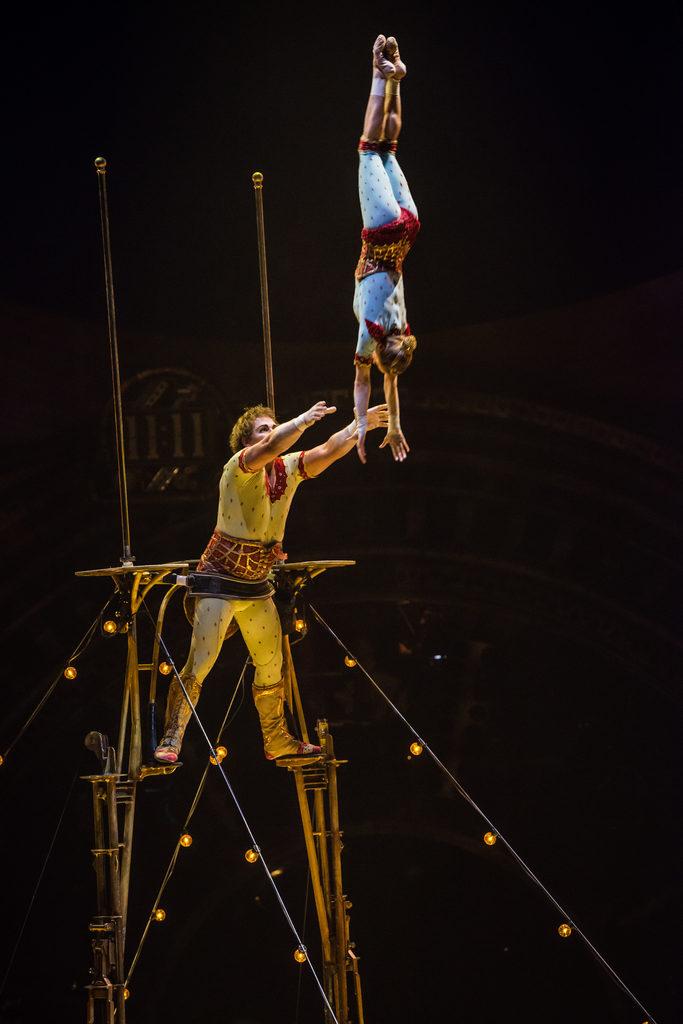
The show, which features 46 artists ages 21 to 37 and over 100 costumes, is the newest installment in the lineup of shows. It is the chance to see astonishing feats of agility, flexibility, strength, balance, coordination and inventiveness. Kurios evokes the eerie world of a 19th-century carnival. It’s a shadowy universe inhabited by strange, and vaguely ominous creatures, such as an accordion man, a serious chap with a cosmic pod for a stomach and a little woman who resembles Angela Lansbury. The production’s settings and costumes suggest a mad scientist’s laboratory and fantasies in the late 19th century.
the late 19th century.
The stage is one of the lowest of all Cirque du Soleil big top shows. It is only 24 inches high. This decision was made by director Michel Laprise so that the artists are closer to the public. The props on stage include coppered Victrola record players, a clanging vintage clock, anti que electric lights, odd robot-like characters with pod faces and bulbous metal midsections. This is a museum-worthy assemblage, created from recycled bits and pieces of leather, metal, old gramophones and typewriters, turbine engines, piping and tubing.
que electric lights, odd robot-like characters with pod faces and bulbous metal midsections. This is a museum-worthy assemblage, created from recycled bits and pieces of leather, metal, old gramophones and typewriters, turbine engines, piping and tubing.
Of course a Cirque du Soleil show would not be complete without acrobats, contortionists, jugglers, and death defying acts, one of which is a dashing chair balancer at a levitating dinner party, and a goggle-wearing aviator who uses his biplane as a platform for a balancing act that has him perching on a gyrating tower of cylinders and planks. James Eulises Gonzalez who performs on the Rola Bola is the only artist who cannot be replaced if stricken ill or injured. He is the only person in the world who can perform this feat.
Kurios also features comedy from the cheeky verve of the ensemble. However, David-Alexandre Després wins laughs as both the overeager suitor of a lovely young woman plucked from the audience, and as an uncannily realistic and raunchy pussycat who won’t leave the poor girl alone. Cirque du Soleil has not deployed clowns often but this show adds one.
“Let’s not forget we are still a circus …,” said Bruno Darmagnac, artistic director of Kurios, “…and since the beginnin g the company made a statement to never ever use any animals in our productions, which is something often expected from a circus. In that sense we went, ‘NO, we will never do that, but clowns..YES.’ And this one is a very special clown. And different. We don’t even call him clown, we call him the comic.”
g the company made a statement to never ever use any animals in our productions, which is something often expected from a circus. In that sense we went, ‘NO, we will never do that, but clowns..YES.’ And this one is a very special clown. And different. We don’t even call him clown, we call him the comic.”
Cirque du Soleil was cofounded by Guy Laliberte and it is now one of the biggest live entertainment groups in the world having performed 35 shows in front of nearly 150 million spectators in more than 300 cities on six continents. He has been aiming to revitalize his company, known for its intricate circus shows as its creative guide.
Laliberte started out as a street performer in Quebec, walkin g on stilts and breathing fire. He founded Cirque du Soleil in 1984 when the Canadian government awarded him a $1 million contract to develop a celebration for the 450th anniversary of the discovery of Canada. Now, Cirque du Soleil has close to 4,000 employees, including 1,300 performing artists from close to 50 different countries.
g on stilts and breathing fire. He founded Cirque du Soleil in 1984 when the Canadian government awarded him a $1 million contract to develop a celebration for the 450th anniversary of the discovery of Canada. Now, Cirque du Soleil has close to 4,000 employees, including 1,300 performing artists from close to 50 different countries.
Darmagnac indicated that Laliberte is involved with every show before it premieres. Shows are put together and then performed in front of Laliberte for final approval. Darmagnac describes this process as “entering the lion’s den.” Each act is meticulously choreographed and Laliberte will either approve each act, make changes, or eliminate it altogether. It makes for a tedious process but each employee of Cirque knows what to expect and knows the final product will be something audiences will enjoy.
Darmagnac has been with Cirque du Soleil since 2011 and before joining Cirque, was the co-creator of FLIC FLAC, a modern traveling circus in Germany. He is excited about the new show. “Allegria [the traveling tour prior to Kurios] was 20 years old. This one is new and the energy is completely 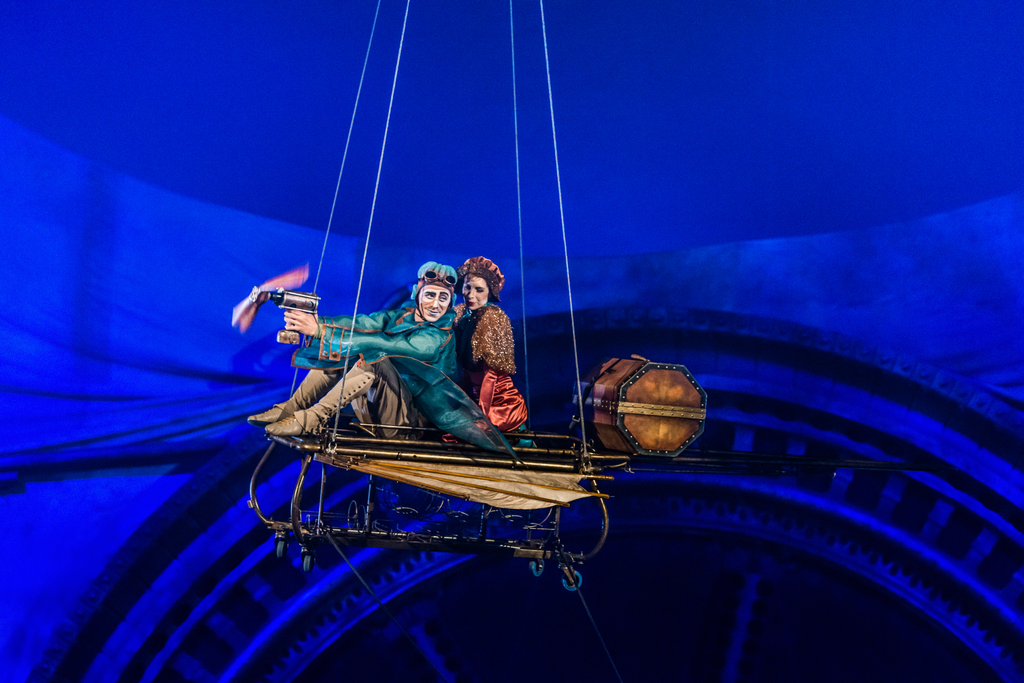 different,” said Darmagnac. “This one [show] really wanted to put humans on stage, with a face and with this steampunk look. Lots of people can relate to it and it will not go out of fashion for a long, long time.”
different,” said Darmagnac. “This one [show] really wanted to put humans on stage, with a face and with this steampunk look. Lots of people can relate to it and it will not go out of fashion for a long, long time.”
Kurios was written and dir ected by Michel Laprise, and features bright and breezy songs by composer-music directors Raphaël Beau and the duo Bob & Bill. The songs are upbeat, unpretentious numbers reminiscent of 1930s French jazz, buoyantly performed by a small, eclectic ensemble. The music kept the audience engaged and complemented the acts.
ected by Michel Laprise, and features bright and breezy songs by composer-music directors Raphaël Beau and the duo Bob & Bill. The songs are upbeat, unpretentious numbers reminiscent of 1930s French jazz, buoyantly performed by a small, eclectic ensemble. The music kept the audience engaged and complemented the acts.
They’re a few of more than a dozen acts in a show that runs close to 2-1/2 hours, including one intermission. The audience at the Denver premiere gave the artists a standing ovation. Kurios — Cabinet of Curiosities tickets can be purchased at www.cirquedusoleil.com/kurios.
All photos: © Martin Girard shootstudio.ca
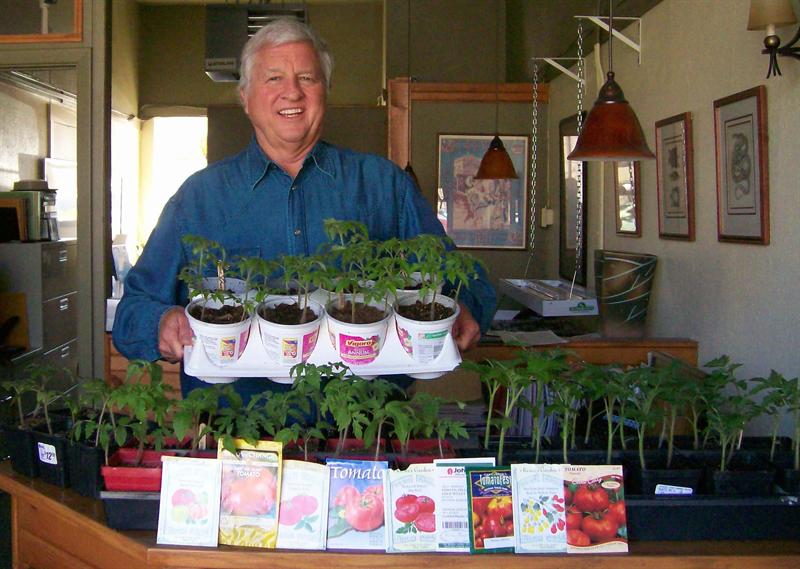
by Mark Smiley | May 26, 2015 | Travel
by Councilman Charlie Brown
For the last eight seasons, Denver City Councilman Charlie Brown has planted thousands of tomato seeds in March and nurtured the plants to distribute free to residents and city officials in early May. He grows them in his basement and office, where they eventually end up in his office windows on Exposition Avenue and are often confused with a newly legalized plant.
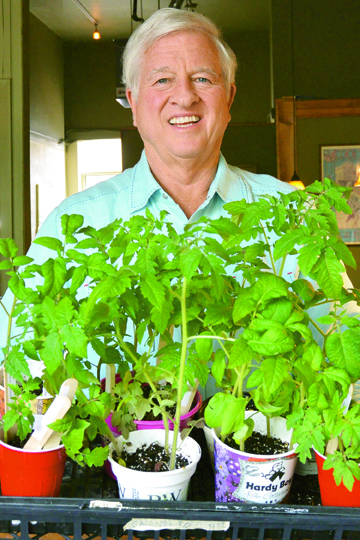 “When that happens,” Brown said, “I always remind folks that tomato plants are not a cash crop.”
“When that happens,” Brown said, “I always remind folks that tomato plants are not a cash crop.”
The second year his efforts proved so popular that constituents started calling in April wanting to know when they could pick up “their” tomato plants. The “The Tomato Plant Entitlement Program” was hatched.
This year was his biggest yet, with more than 800 plants and 15 varieties handed out. And it will be the last year to do so, since along with five other Denver council members, he is term-limited in July. He has represented 52,000 residents in south Denver for more than 14 years.
Brown calculates he has distributed some 6,000 tomato plants during the last eight years which, if urban gardeners followed his tip sheet for growing in Denver’s fickle climate, produced 20,000 pounds of America’s favorite gardening crop. And with this era ending, he wanted to share how he got started — not with politics, but with gardening.
The love affair began decades ago.
My first gardening memories can be traced back to my grandparents’ small farm five miles east of Durham, N.C. When we were about 10-years-old, my Mom would take my twin brother and me there to spend the weekend helping them with farm chores.
Saturday mornings started early. A rooster’s cock-a-doodle-doo would send us dashing off to the hen house to gather fresh brown eggs for breakfast. That was the easy start of a long day working in the heat and humidity and the sandy clay soils of North Carolina’s Piedmont region. We milked cows, fed the pigs and chickens, and tackled the dreaded hoeing and weeding.
I would do things that city folks have trouble understanding, including wringing a chicken’s neck for Sunday supper and watching it run around the barnyard with no head; and plowing long rows of crops with a large, tail-swishing beast six feet in front of me who, surprisingly, respected my commands of “whoa mule!” I loved every minute of it, especially the gardening.
The southern climate allowed for early planting and harvesting. It’s hard for Denver gardeners to fathom that by late June we were already “bringing in” potatoes, broccoli, spinach, beets, onions, field peas, squash, butter beans, string beans, green peppers and, my favorite, tomatoes. Okra, turnip greens, cantaloupe, watermelon and corn would soon follow. Most crops would be “put up” in canning jars or, later, a small Sears & Roebuck freezer.
As I look back on those days I realize just how much my grandparents taught me. My grandmother was an early naturalist, who loved birds, wildlife and gardening. “Gardening teaches you patience,” she said. She reminded us not to keep all the fish we caught from the scummy farm pond but return some for ‘another day’ long before the concept of “catch and release.” My grandfather was a hard task master. If he would catch us leaning on our hoe to catch a quick break he would yell out: “You have to hoe to the end of the row,” a work ethic that’s sometimes hard for youngsters to comprehend.
Thanks to the influence of my grandparents, I’ve planted a garden each spring for more than 40 years. It gets in your blood. When it hails in Denver everyone is concerned about their cars and roofs. But like all farmers, ranchers and urban gardeners, our concern is about, in the words of Kenny Rogers, “our crops in the field.”

 Cherry Creek Valley resident Elizabeth (Biz) Erickson, age 31, watched as her sister Emily, age 36, slowly wasted away and began to die from the liver disease Primary Sclerosing Cholangitis (PSC) as she waited for a transplanted liver from a cadaver. Football legend Walter Payton died from PSC at age 45 and now his football coach Mike Ditka has the very same disease.
Cherry Creek Valley resident Elizabeth (Biz) Erickson, age 31, watched as her sister Emily, age 36, slowly wasted away and began to die from the liver disease Primary Sclerosing Cholangitis (PSC) as she waited for a transplanted liver from a cadaver. Football legend Walter Payton died from PSC at age 45 and now his football coach Mike Ditka has the very same disease.



















